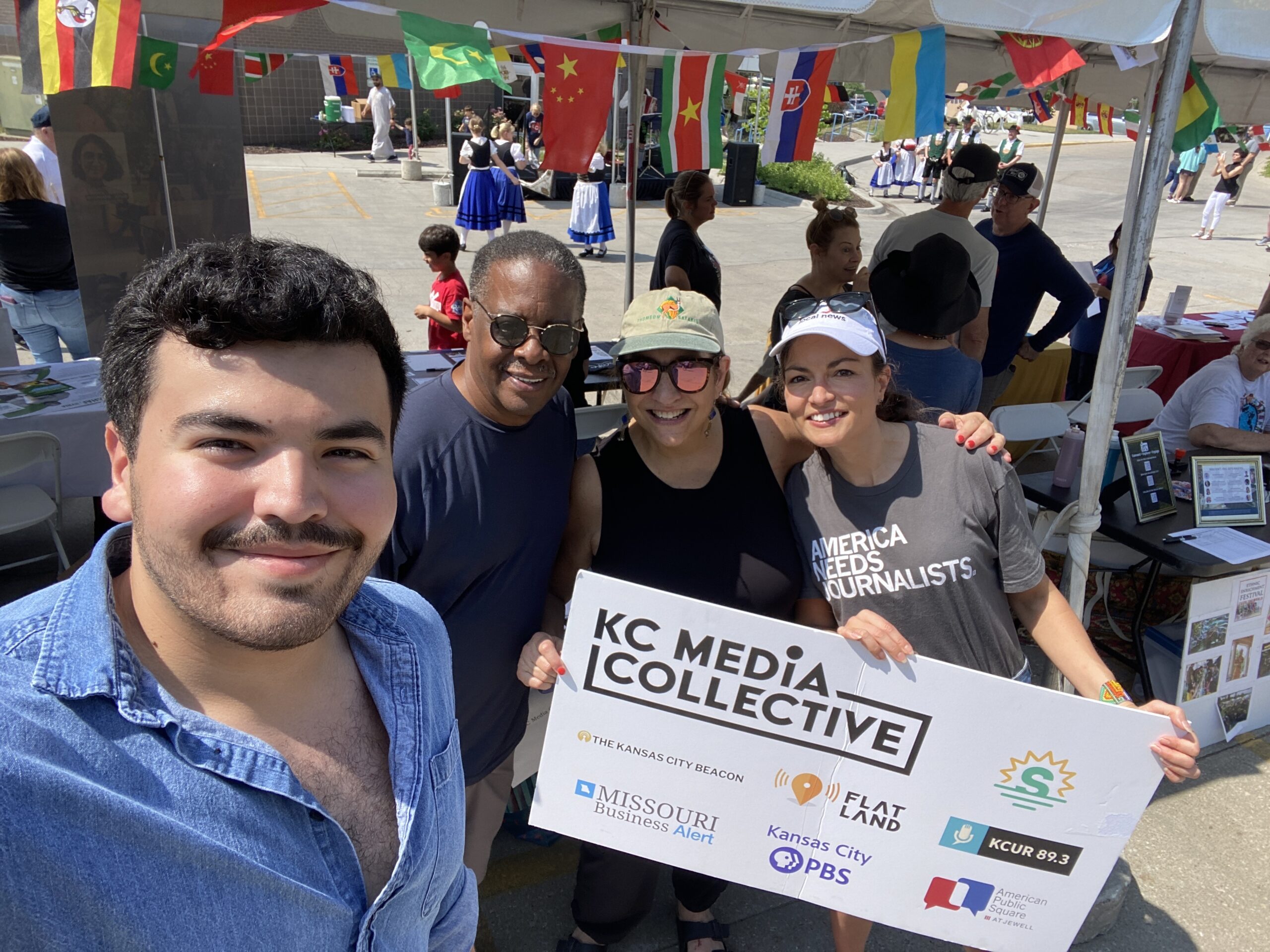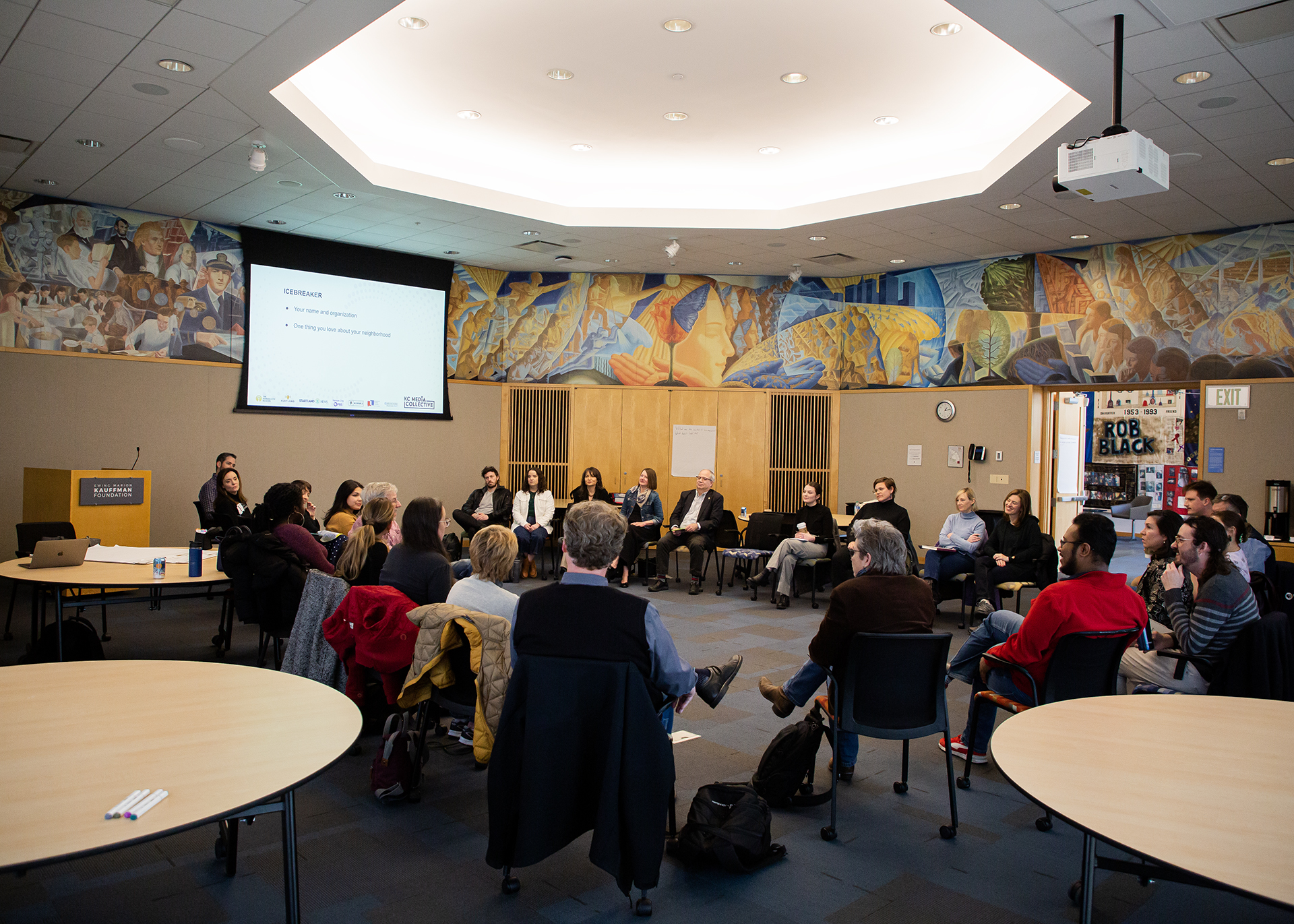The pros and cons of building a local media collaborative
Kalie Hudson, Kansas City PBS,
Journalists from different outlets share ideas during a monthly meeting of the Kansas City Media Collective. (KCMC)
Here’s an idea to steal and adapt: Discover how a group of nonprofit, public media organizations in Kansas City joined forces to sustain local journalism.This is a series on Better News to a) showcase innovative/experimental ideas that emerge from the Knight-Lenfest Newsroom Initiative and b) share replicable tactics that benefit the news industry as a whole.
This “win” comes from Kalie Hudson, chief content officer at Kansas City PBS. Kansas City PBS/Flatland, American Public Square, KCUR, Missouri Business Alert, Startland News and The Beacon make up the Kansas City Media Collective, which participated in the Poynter Table Stakes program in 2023.
Question: What problem were you trying to solve, and why was that problem strategically important to your organizations?
Answer: The decline of journalism is well-documented. The industry experienced a sharp downturn in the early 2000s as audiences—and advertising revenue—migrated to digital platforms. Local newspapers suffered the most, as the digital shift coincided with hedge fund acquisitions that consolidated the industry and prioritized cash flow over covering the news, leading to massive reductions in journalism jobs.
As local newspapers waned, trust in mass media also diminished when the quantity and quality of local coverage declined. Increasingly, Americans turned to partisan sources and social media for their news, eroding informed civic participation.
All six of the organizations involved in the Kansas City Media Collective are invested in supporting balanced, fact-based information and constructive conversation on issues affecting the community.
To date, collective members are all nonprofit media and media-adjacent organizations whose financial sustainability relies on community support. These locally supported journalism organizations can survive through hybrid financial models focused on membership and philanthropy, but individually they do not match the workforce of legacy newspapers.
Even with financial sustainability, they may not have the resources to fill all the coverage gaps.
Q: How did you go about solving the problem?
A: As journalism organizations nationwide strive to sustain themselves and serve their communities, some have united to share resources and work collaboratively. These relationships have proven scalable in ways that individual organizations often find challenging.
Enter the Kansas City Media Collective.
Before forming a formal collective, key players such as Kansas City PBS (Flatland), KCUR, Missouri Business Alert, Startland News and The Beacon had already engaged in short-term collaborations.
They had also worked with journalism-adjacent organizations, including American Public Square at Jewell, on community engagement. So, when the Ewing Marion Kauffman Foundation indicated an interest in stimulating more innovative and effective collaborations in journalism in the Kansas City area, these local organizations put their hats in the ring for funding support.
With their established relationships, the respective organizations formalized and expanded their collaborations by forming the Kansas City Media Collective in 2021.
All members are focused on serving the community through the creation, curation and distribution of trustworthy news and information.
American Public Square at Jewell is a Kansas City-based nonprofit dedicated to enhancing public discourse through events and resources promoting civility and balanced perspectives.
Kansas City PBS and its local journalism outlet, Flatland, provide diverse content on civic affairs, social equity and education on multiple platforms. KCUR, the flagship NPR station in Kansas City, delivers vital news and entertainment and leads several regional collaborations.
Missouri Business Alert, a digital newsroom at the Missouri School of Journalism, informs and connects the statewide business community. Startland News highlights Kansas City’s innovation ecosystem through storytelling.
The Beacon offers in-depth, data-driven journalism on critical regional issues.
Each entity offers free access to users, is devoted to local issues and is dedicated to equitable coverage.
Through the formation of the Kansas City Media Collective, the partners pool resources and leverage each other’s strengths to provide better coverage for the community and internal relief for their staffs.

Representatives of the Kansas City Media Collective connect with immigrant communities in Kansas City’s Historic Northeast at a 2023 World Refugee Day event. (KCMC)
Q: What worked?
A: The passion and dedication of the members.
The team, composed of journalists, editors and administrative personnel at all levels, had a cause it believed in and was motivated to make it work. By meeting regularly, forming specialized committees and building a foundational trust among all stakeholders, the collective has turned “competitors” into partners. This work has expanded services to Kansas City audiences in myriad ways.
Content sharing: The collective supports content sharing, ranging from a story that is produced by one entity and shared by other collective members to a story that is conceptualized in a collaborative fashion and shared across platforms. Members pursue reporting that involves multiple newsrooms collaborating on a multimedia package that is shared across multiple media platforms, and/or coordinating a community engagement event or discussion.
Shared staffing resources: Key stakeholders form a multidisciplinary team from across the organizations, including managing editors, reporters, engagement staff and organizational leaders who serve on committees based on their expertise. In 2023, three of the six collective members started a shared intern program. Missouri Business Alert helped support two paid intern positions, with one stationed at Kansas City PBS/Flatland and the other at KCUR. These interns produced stories of mutual interest, featured across all platforms, enhancing the collaboration and content quality while providing Columbia-based Missouri Business Alert a physical presence in Kansas City and editorial support from the partner organizations.
Broader coverage: Unique coverage by these organizations has never been more supported as key stakeholders in the organizations share ideas and editorial calendars freely. This allows for a broader range of coverage on topics by supporting a variety of angles, effectively reducing redundancies.
Q: What didn’t work?
A: The passion and dedication of the members.
In the early days, there was a lot of discussion of the “why” behind what the participants were doing and not as much focus on the “how.” This led to confusion and miscommunication as far as processes and workflows go.
Simple conundrums like how to credit each other, how to set goals and what committees would most effectively support the collective goals were all undecided as team members dove into the work. This led to confusion and some tension at times.
In the winter of 2023, four out of the six collective participants sent representatives to the Poynter Institute to kick off work in the Local News Innovation Program.
The initiative was designed to bring together cross-functional leadership teams from news organizations to provide a pathway for transforming a news organization into an audience-focused, digital-first, market-leading, sustainable enterprise.
The Kansas City Media Collective, the first of its type to enter the program, engaged in a large-scale project to show that local journalism is a pillar of thriving communities by improving civic engagement in areas with low voter turnout.
This exercise was integral to formalizing the work of the collective and pushing the team toward deep collaboration. Until that point, the collective members had consistently convened and participated in multimedia collaborations and events.
However, they had not undertaken an initiative that demanded a shared vision from the outset, along with clearly defined goals and regular assessments of progress. This prolonged commitment required a new level of alignment and prompted the collective members to build muscles in workflows and processes that they previously didn’t have.
Q: What happened that you didn’t expect?
A: The core group of the personnel and the projects of the collective has continued to grow even without a directive or additional funding. The continued success of the collaboration has spurred the undertaking of even larger and more impactful projects.
In this critical election year, the Kansas City Media Collective is dedicated to covering the 2024 election cycle for the benefit of the Kansas City area’s residents.
This project will serve a bi-state region home to over 2 million people across 14 counties and will produce a comprehensive Voter Guide in print and digital forms. The guide will include coverage and analysis of candidates and issues at local, state and federal levels. It will be distributed to the widest possible audience across the Kansas City region through engagement with community organizations, at events and at venues such as community centers and grocery stores.

Members of the Kansas City Media Collective, from all participating organizations, strategize for the upcoming year at an annual retreat. (KCMC)
Q: What advice would you give to others who try to do this?
A: Get a project manager… Seriously.
We understand that the addition of a staff member might not be feasible for everyone, but it was critical to the ongoing success and the expansion of the work that the collective does. This role was essential in enabling the collective to shift resources from administrative tasks to focus more on strategy and content. With six organizations involved, the initial process was somewhat complex.
We convened a small group with representatives from each organization to identify and address various gaps. However, a more detailed discussion about workflows, decision-making processes and connections to the executive committee could have made the transition smoother for our candidate. Additionally, an earlier brainstorming session with a larger group of stakeholders would have provided a more comprehensive understanding of our collective needs.
Q: What’s next for this work?
A: It’s a tale as old as time. Journalism collaborative receives a three-year grant to do valuable work that benefits the community. After three years, they wonder where the time has gone and how they will fund continued efforts.
As previously mentioned, the initiative has been successful in putting more information into the hands of more people in Kansas City.
As the original grant term enters its final year, we are having conversations about seeking additional funding. We’ve submitted an application to a local foundation requesting the extension of the support for the project manager role. There is also an interest in adding more partners to expand the work past that of the original six organizations. But that would require additional funding to ensure equitable participation for any new partners and provide incentives to compensate for the resources they would need to contribute.
To that same end, the collective is interested in retaining more administrative backbone to manage more partners and expand bandwidth within the collective. The project manager has absorbed the necessary administrative work to free up journalists, editors, community engagement and marketing personnel to focus on the content and promotions.
In early 2024, the Kansas City Media Collective embarked on a large-scale, regional initiative to provide widespread coverage of the 2024 election cycle.
The collaboration, which enticed The Kansas City Star to join as a partner, features the work of over 40 journalists and will ensure detailed coverage of more than 100 races from local to federal levels in Kansas and Missouri.
The 2024 KC Voter Guide will be available online and in print, in both English and Spanish, and will be widely distributed across the Kansas City region. The guide includes candidate and issue analysis and essential voter resources, and will be updated after the August primaries for the general election in November.
The Voter Guide is a critical service. We can do more of those types of projects with more support.